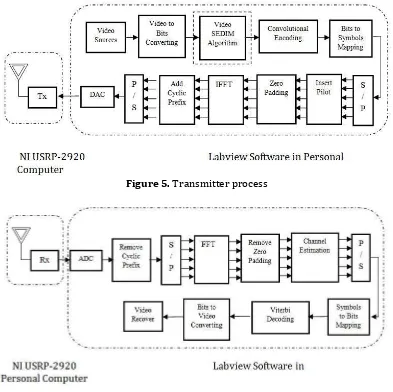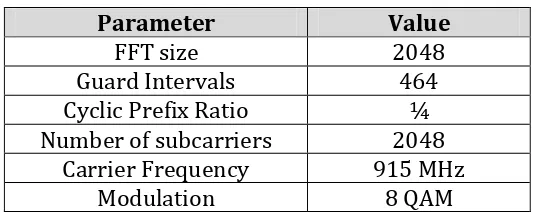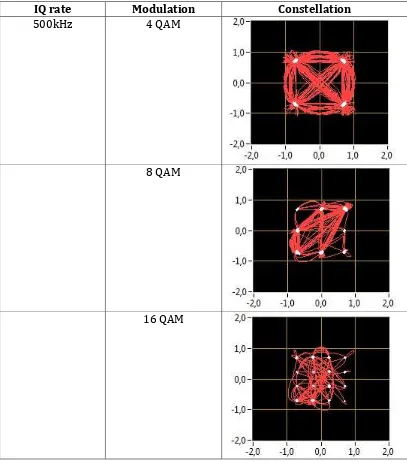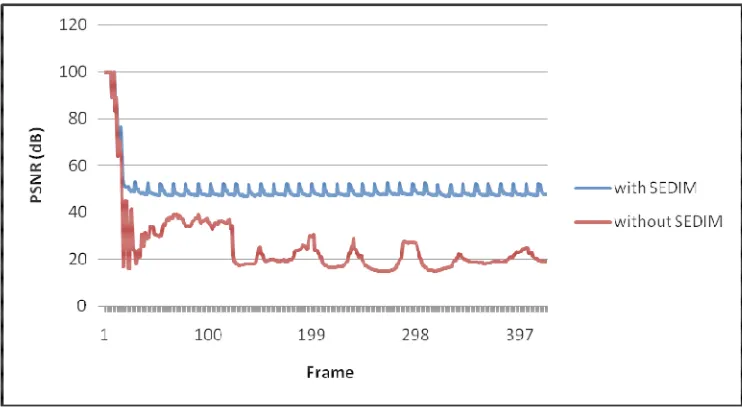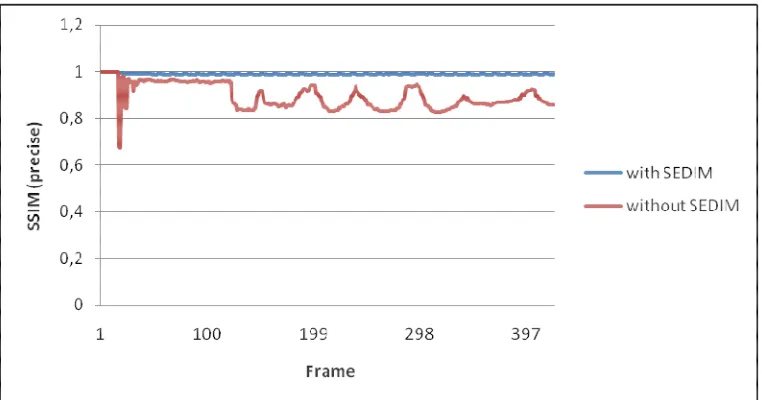Performance Analysis of Video Transmission
Using Sequential Distortion Minimization Method for
Digital Video Broadcasting Terrestrial
Novita Astin, I Gede Puja Astawa, Amang Sudarsono
Politeknik Elektronika Surabaya
Jl. Raya ITS-Kampus ITS Sukolilo, Surabaya 60111, INDONESIA Telp : 6231 594 7280, Fax: 6231 594 6114
Email: [email protected], [email protected], [email protected]
Abstract
This paper presents about the transmission of Digital Video Broadcasting system with streaming video resolution 640x480 on different IQ rate and modulation. In the video transmission, distortion often occurs, so the received video has bad quality. Key frames selection algorithm is flexibel on a change of video, but on these methods, the temporal information of a video sequence is omitted. To minimize distortion between the original video and received video, we aimed at adding methodology using sequential distortion minimization algorithm. Its aim was to create a new video, better than original video without significant loss of content between the original video and received video, fixed sequentially. The reliability of video transmission was observed based on a constellation diagram, with the best result on IQ rate 2 Mhz and modulation 8 QAM. The best video transmission was also investigated using SEDIM (Sequential Distortion Minimization Method) and without SEDIM. The experimental result showed that the PSNR (Peak Signal to Noise Ratio) average of video transmission using SEDIM was an increase from 19,855 dB to 48,386 dB and SSIM (Structural Similarity) average increase 10,49%. The experimental results and comparison of proposed method obtained a good performance. USRP board was used as RF front-end on 2,2 GHz.
Keywords : DVB-T, OFDM, SEDIM, USRP, Convolutional Code
1. INTRODUCTION
EMITTER International Journal of Engineering Technology, ISSN: 2443-1168
new types of services that could be transmitted using digital video broadcasting terrestrial (DVB-T)standard.
Digital Video Broadcasting Terrestrial (DVB-T) is a digital transmission system that delivers a series of data at the symbol rate. DVB-T using Orthogonal Frequency Division Multiplexing (OFDM) in order to help the receiver to counter the effect of multipath environment. As demand for bandwidth is increasing, OFDM is introduced as one of the solutions to enable bandwidth efficiency and robustness due to intersymbol interference (ISI) in the consequence of multipath fading environment [1]. Dividing high rate data stream into parallel low rate data streams using Fast Fourier Transform is the main principle of OFDM [2].
DVB standard uses MPEG-2 compression standard as a data container. With the conception of the transmission of digital information can be done flexibly without needed to impose limits what type of information will be stored in the container the data. The MPEG2 transport streams packets of constant length that have been optimized for DVB-T. Length MPEG-2 TS packet is 188 bytes,consisting of 4 byte header and an 184 byte payload. The payload consists of video, audio or data in general, while the header is composed of various essential items for packet transmission. Protocol and format of TS to DVB-T are compatible parts in the MPEG-2 specification defined in ISO / IEC 13818-1. This format is based on the approach to the transport stream packet length which is fixed and has been optimized for DVB-T.
In the video transmission, distortion often occurs. Key frames selection algorithm is flexibe on an change of video but on these method the temporal information of a video sequence is omitted. To minimizes distortion between the original video and received video, we purpose to add methodology using sequential distortion minimization algorithm. Its aim is to create a new video, better than original video without significant loss of content between the original video and received video, fixed sequentially. The ratio between the temporal duration of the original video and received video is equal to α Є [0,1]. The number frames of original video denote as N, so the number frame of received video consists of α.N as representative key frames. The real speed of the new video has been increased by the factor of 1/α on average.
To transmit DVB-T system signal based on OFDM using Universal Software Radio Peripheral (USRP). USRP is RF front end which can be used for good performance in wireless implementation.
This paper is organized as follows. In Section I we present introduction. Related work of this research is described in Section II. Then, in Section III, we explain our proposed method. In section IV, we explain about the DVB-T system, shot detection, sequential distortion minimization method, OFDM system, Convolutional code and USRP system. Then, system implementation is described in Section V. In Section VI, we discuss the experimental result. Finally, our conclusion is presented in Section VII.
2. RELATED WORKS
Video distortion often occurs on video transmission. The selection of key frames is usually done to minimize video distortion. The most of key frames selection techniques assume that the video has been segmented into shots and then extracted within each shot a small number of representative key frames. A shot can be defined as a sequence of frames that are (or appear to be) continuously captured from the same camera. Key frames can be defined as a subset of a video sequence that can represent the video visual content as close as possible, with a limiting number of frames [7]. Key frames selection approaches can be classified into: cluster-based methods, energy minimization-based methods and sequential methods. The clustering techniques take all the frames of a shot together and classify them according to their content similarity. Then, the key frames are determined as the representative frame of a cluster. The disadvantage of these approaches is that they ignore the temporal information of a video sequence.
Costas Panagiotakis, Nelly Ovsepian, and Elena Michael proposed video synopsis based on a sequential distortion minimization method. The main goal is to select from a video the most significant frames in order to broadcast so that the visual content distortion between the initial video and the synoptic video is minimized[4]. The proposed method sequentially minimizes this distortion, resulting high performance in any value of the parameter α that controls the number of frames of video synopsis. Furthermore, the method can be used in any video content description.
P. Goudarzi, M.Hosseinpour use distortion minimization for transmitted video sequence in Mobile Ad hoc Network. Intrinsic high levels of packet error probability in Mobile Ad hoc Network (MANETs) can cause high levels of distortion based on the position of packet loss in transmitted frames. Hence, exact modeling of the impact of packet loss on video quality and the resulting distortion is an important task. Many conventional distortion modeling techniques simply consider a linear relationship between the packet loss and distortion, which is inaccurate. The main contributions of the current work are twofold. At first, an accurate model has been developed, which can capture the exact effect of network packet loss on video quality performance (and hence on the QoE) with Group Of Picture (GOP)-level granularity. Then, based on this model, an optimal bandwidth allocation strategy is developed in MANETs, with which, based on some network-specific constraints, the loss-induced distortion associated with a video source is minimized, using some cross-layer design techniques. Finally, the resulting optimal rates can be used as rate-feedbacks for on-line rate adaptation of an appropriate video encoder, such as H.264/AVC.
EMITTER International Journal of Engineering Technology, ISSN: 2443-1168 3. ORIGINALITY
This paper presents performance analysis of video transmission using sequential distortion minimization method for digital video broadcasting terrestrial with good performance on IQ rate and modulation. DVB standard uses MPEG-2 compression standard as a data container so the transmission data can be done flexibly. In addition, method using sequential distortion minimization algorithm resulted a new video according to a given parameter α for the best performance on digital video broadcasting terrestrial system. The method is divided into several steps. The first is estimated Color Layout Descriptor (CLD). Then, shot detection uses lightness histogram of each frame with next one. Sequential Distortion Minimization algorithm for the new video is select the number of frames for the shots so that the distortion between the original video and new video is sequentially minimized. Digital video broadcasting constructed using Labview platform and implemented in real condition using NI USRP-2920 on 2,2 GHz carrier frequency.
4.SYSTEM DESIGN
4.1 DVB-T System Overview
DVB-T is stands for " Digital Video Broadcasting — Terrestrial " it is the DVB European-based consortium standard for the broadcast transmission of digital terrestrial television that was first published in 1997 and first broadcasted in the UK in 1998. This system transmits compressed digital audio, digital video and other data in a MPEG transport stream, using coded orthogonal frequency-division multiplexing (COFDM or OFDM) modulation.
In the DVB standard using MPEG-2 compression standard as a data container. With the conception of the transmission of digital information can be done flexibly without needed to impose limits what type of information will be stored in the container the data. The MPEG2 transport streams packets of constant length that have been optimized for DVB-T. Length MPEG-2 TS packet is 188 bytes, consisting of 4 byte header and a 184 byte payload. The payload consists of video, audio or data in general, while the header is composed of various essential items for packet transmission.
In Figure 1 can be explained some of the functions parts of the header. The first header byte is the length of the packet sync byte with 8 bits. Sync byte is used for synchronization or the initial identification of a transport stream packet, while transport error indicator is used to identify the error bit in the TS packet. A packet identifier (PID) has a length of 13 bits package, serving to identify the TS packets carrying data of the same elementary stream. Protocol and format of TS to DVB-T are compatible parts in the MPEG-2 specification defined in ISO / IEC 13818-1. This format is based on the approach to the transport stream packet length which is fixed and has been optimized for DVB-T.
4.2 Shot Detection
The aim of shot detection is to find out the percentage of the frames of each shot that are capable enough to represent the whole shot. The equation can be written as follows :
(1)
where :
Lk is the sum of sequential visual changes of shot k
SHk denotes the set of frames of shot k
4.3 Sequential Distortion Minimization
To minimize the distortion between the original video and new video is select bk frames for the k shot. Initially, we set CANk = SHk and Sk = Ø denoting as the frames of new video of shot k. For each shot k we iteratively select the frame f from CANk so that if we include it in set Sk the new video distortion is minimized. Then remove it from set CANk and we add it to set Sk :
(2)
EMITTER International Journal of Engineering Technology, ISSN: 2443-1168 Figure 2. Scheme of video sequential distortion minimization[4]
4.4 Orthogonal Frequency Division Multiplex (OFDM)
OFDM (Orthogonal Frequency Division Multiplexing) is a multicarrier transmission technique, where inter subcarrier one another mutually orthogonal. Due to the nature of this orthogonality between adjacent subcarriers can be made without causing overlapping intercarrier interference (ICI). This would make OFDM has higher spectral efficiency.
Figure 3. OFDM Signal spectrum
OFDM is a modulation technique that is used for DVB-T standard. With OFDM modulated data are transmitted in parallel via subcarriers.The concept of OFDM is to divide the data rate wideband information signal into parallel rows of data with a data rate that is lower than parallel data is modulated with mutually orthogonal subcarriers. This is one of the advantages of OFDM since the original channel is frequency selective fading will be perceived as flat fading by each subcarrier, so the signal distortion due to multipath fading canal treatment is reduced. To shorten the computing time can be implemented algorithm fast Fourier transform (FFT).
The disadvantage of OFDM is the peak average power ratio, this is because the power of the transmitted signal is the sum of the power of the subcarrier so the impact on the power amplifier. The expression for one OFDM symbol starting at t = ts as follows:
Video CLD
Shot Detection
Number of Frames
per Shot
Sequential Distortion Minimization
(3)
s(t) = 0, t < ts
t > ts + T
Where :
di = complex modulation symbol
Ns = number of subcarriers
T = symbol duration fc = frequency carrier
IFFT and FFT process is key in OFDM. IFFT serves as a symbol of manufacture (modulator) OFDM and FFT as decomposers of OFDM symbols (demodulator) [6]. FFT and IFFT equation can be written as follows.
FFT :
(4)
IFFT :
(5)
Where :
x(k) = number of FFT/IFFT N + number of subcarriers
4.5 Convolutional Code
EMITTER International Journal of Engineering Technology, ISSN: 2443-1168 Figure 4. Convolutional code circuit generator
The output of the convolutional encoder and then through the process of modulation and transmitted through the channel, on the receiver side through the demodulation process and then go on the convolutional decoder. In this part encoder must begin and end at a known state so that the decoder can be obtained by a sequence of bits are correct.
4.6 Universal Software Radio Peripheral (USRP)
USRP is a flexible radio that turns a standard PC into prototyping platform. Manufactured by National Instrument (NI), USRP 2920 paired with NI LabVIEW software.Tuneable center frequency from 50 MHz to 2,2 GHz covering FM radio, GPS, GSM, radar and ISM bands, NI USRP 2920 transceivers provide relevant, laboratory learning in RF and communications experimentation in multiple frequency bands.
5. IMPLEMENTATION
symbol with 1 zero at DC carrier.Then cyclic prefix is inserted 504 bits from duplicating the last OFDM symbols to beginning OFDM symbols. Then the digital signal is converted to analog signals with carrier frequency 2,2 GHz and transmit using USRP as RF front end.
The signals are received and converted to digital signals. USRP initialize with open Rx session and signal configure. On receivers side processing symbol OFDM becomes to beginning the process on the transmitter. The transmission process can be seen in Figure 5 and Figure 6.
Figure 5. Transmitter process
EMITTER International Journal of Engineering Technology, ISSN: 2443-1168 Table 1. Parameter of OFDM System
Parameter Value system[1],which is can be seen on Table 1.
6. EXPERIMENT AND ANALYSIS
This experiment uses two PCs and two USRP 2920 as transmitter and receiver.The practical measurement includes the reliability of streaming video transmission on different IQ rate and modulation investigated by constellation diagram.Then the performance of Sequential Distortion Minimization method on the DVB-T system with α = 0,1 observes based on PSNR ( Peak Signal to Noise Ratio ) and SSIM ( Structural Similarity ).
6.1 The reliability of video transmission measurement.
The purpose of this experiment is to observe the reliability of the DVB-T system. The video sent using USRP 2920 with frequency 2,2GHz, indoor environment. The experiment is used different IQ rate and modulation. If the IQ rate is increased, spectrum bandwidth will go up too and computation of computer host is increasing too[9]. Table 2 shows constellation diagram on different IQ rate and modulation. The reliability system is achieved when IQ rate under 2Mhz and modulation under 8 QAM. When IQ rate is more than 5MHz and modulation is more than 16 QAM, the video transmission is an error. Video transmission encountered an error while the higher-order modulation. The higher-order modulation, the more susceptible to noise resulting in error. The computing process on USRP tool also higher so USRP tool specification does not compatible.USRP is not support for condition 5MHz and 10MHz at 16 modulation scheme.
6.2 The performance of Sequential Distortion Minimization Method.
Table 2. Comparison the reliability of the system on different IQ rate and Modulation
IQ rate Modulation Constellation
500kHz 4 QAM
8 QAM
EMITTER International Journal of Engineering Technology, ISSN: 2443-1168
1MHz 4 QAM
8 QAM
16 QAM
8 QAM
16 QAM
5MHz 4 QAM
8 QAM
EMITTER International Journal of Engineering Technology, ISSN: 2443-1168
10MHz 4 QAM
8 QAM
16 QAM Error
Specification IQ rate and modulation based on the best performance on investigation earlier, which is IQ rate 2 MHz and modulation 8 QAM.
PSNR compares the maximum possible signal energy, i.e, the maximum value of the luminance component of the frame, to the noise energy, that is the mean square error (MSE) computed pixel by pixel between the source frame and the received frame[5].The PSNR in dB can express as :
(6)
x denote as source frame and y as received frame. MSE(x,y) denotes the mean square error between x and y. Vpeak = 2k -1, where k is the number of bits per pixel.
SSIM metric is closer to human vision system than PSNR. SSIM is a measure of structural information change can,therefore be used to assess perceived image distortion based on luminance, contrast and structure of an object in the shot. The SSIM index can be expressed as :
SSIM (x,y) = (2μxμy + C1) (2 xy + C2)
( μx2 + μy2 + C1) ( x2 + y2 + C2)
Where xy is the covariance of x and y. C1, C2 are small constant included to
avoid instability when the other terms of the denominators are very close to
0. μx, μy is the mean intensity and x, y is the standard deviation of a signal x
and y.
According to this experiment, video transmission using DVB-T system without SEDIM produce PSNR average 19,855 dB. Video transmission using the DVB-T system with SEDIM produce PSNR average 48,386 dB. The result show the value of PSNR with SEDIM is better than without SEDIM.The graph shown in Figure 7.
Figure 7. PSNR comparison results without SEDIM and with SEDIM
EMITTER International Journal of Engineering Technology, ISSN: 2443-1168 Figure 8. SSIM comparison results without SEDIM and with SEDIM
7. CONCLUSION
In this paper, we have presented some experimental studies video transmission using sequential distortion minimization method for Digital Video Broadcasting Terrestrial and then implemented to USRP. We have studied the reliable system based on IQ rate and modulation. Good performance achieved in IQ rate 2 MHz and 8 QAM. PSNR average was increased more than twice by using SEDIM from 19,855 dB to 48,386 dB. The proposed method also increased 10,49% from 0,896 to 0,99 in SSIM average. Moreover, we intend to study higher video resolution due to future works.
REFERENCE
[1] ETSI EN,Digital Video Broadcasting Frame Structure and
Modulation,EBU-UER, 2009,France.
[2] Fischer W,”Digital and Audio Broadcasting Technology”, Rohde & Schwarz GmbH & Co.KG, Muchen, 2010
[3] ETSI EN 300 744 V1.5.1 (2004-11). “Digital Video Broadcasting (DVB); Framing structure, channel coding and modulation for digital
terrestrial television”.ETSI, 11/2004
[4] Panagiotakis Contas, Ovsepian Nelly, Michael Elena, "Video Synopsis
Based on Sequential Distortion Minimization Method",Computer
Science,University of Crete, 2013
[5] Tommasi Franco, De Luca Valerio, Melle Catiuscia, "Packet losses and
objective video quality metrics in H.264 video streaming", University
of Salento, Italy, 2014
[7] Panagiotakis Costas,oulais Anastasios, Tziritas Gergios "Equivalent Key Frames Selecion Based on Iso Content Distance and Iso Distortion
Principle", Greece, 2003
[8] Briantoro Hendy, Astawa I Gede Puja, Sudarsono Amang, "An Implementation of Error Minimization Data Transmission in OFDM
using Modified Convolutional Code", Politeknik Elektronika Negeri
Surabaya, Indonesia, 2015
[9] OFDM Simulation Using Matlab http:// www.ece.gatech.edu / research /labs /sarl /tutorials/ OFDM/Tutorial_web.pdf
[10] Zainudin Ahmad, Astawa I Gede Puja, Sudarsono Amang,"Performance Analysis of an OFDM PHY Scheme with Zero Forcing Equalizer Using
Software Defined Radio Platform and USRP"
[11] Sudipta Ghoss, Ankit Bass, "Implementation of DVB-T using OFDM on
Phisical Sub Layer" India.
[12] John Biggeni, "DVB T/T2 Fundamentals", Malaysia.
[13] Arfianto Teguh,"Optimasi parameter transmisi OFDM untuk DVB-T
pada penerimaan tetap dan bergerak" Universitas Mercu Buana
[14] Nuaymi Loutfi, “WIMAX Technology for Broadband Wireless Acces” John Wiley & Sons Ltd, England, 2007
[15] Diego A Sano "A performance study of DVB-T2 and DVB-T2-Lite for
mobile reception" 2014
[16] Athinarayanan Vallavaraj "The Effects Of Convolutional Coding On Ber
Performance Of Companded Ofdm Signals", 2005
[17] Dedi Usman Effendy "Analisis Unjuk Kerja Sistem Digital Video
Broadcast (DVB)", 2009
[18] P. Goudarzi, M.Hosseinpour " QoE enhancement for video transmission over MANETs using distortion minimization ", 2010
[19] Dosselman Richard, Yang Xue Dong " A comprehensive assesment of

![Figure 2. Scheme of video sequential distortion minimization[4]](https://thumb-ap.123doks.com/thumbv2/123dok/4040637.1984057/6.595.178.417.365.496/figure-scheme-of-video-sequential-distortion-minimization.webp)

